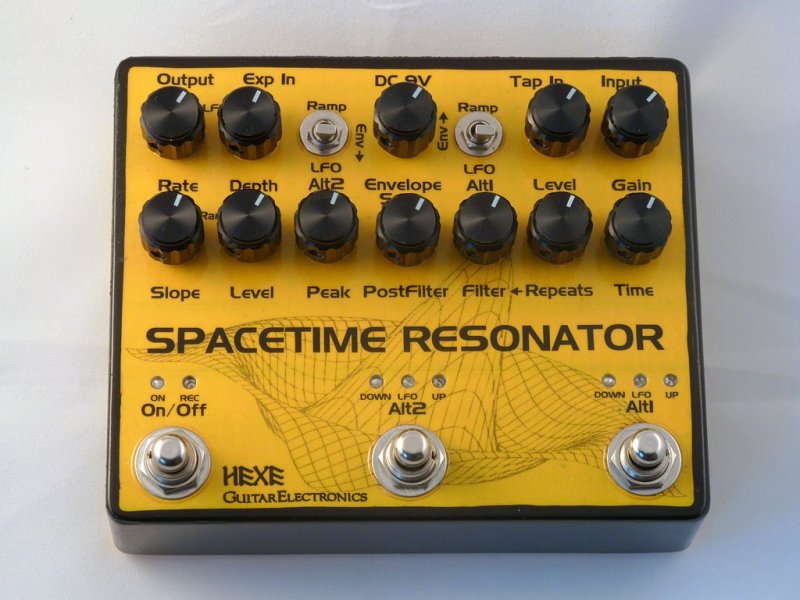
Experimental delay/reverb pedal with a vast modulation capabilities.
Built as a developing test bed for the new assignable modulation modules.
Controls:
-
Delay/Reverb section:
- Gain - input gain.
- Time - delay/reverb time.
- Repeats - delay feedback parameter, goes up to self oscillation.
- Filter - a lowpass, through flat (middle position) to highpass filter placed inside the feedback loop.
- Level - delay/reverb level added to the dry signal.
- Post filter section (resonant lowpass filter):
- Post Filter - filter cutoff frequency.
- Peak - filter resonance parameter.
- LFO section:
- Rate - oscillator speed.
- Depth - together with the assigned parameter's knob controls the LFO operating range.
- Ramp generator section:
- Slope - ramp slope/speed.
- Level - together with the assigned parameter's knob controls the top/bottom boundaries for the ramp signal.
- ENV section:
- Sensitivity - envelope follower sensitivity.
- ALT1 & ALT2 sections:
- ALT config - three way switch used to set the ALT module operation mode: LFO, Ramp or ENV.
Footswitches:
-
ON/OFF:
- Short click - switches the delay/reverb on and off with tails mode on (REC led indicates when the signal is fed into the delay line).
- Long press - used to switch the delay/reverb off and mute the tail (reset mode).
-
ALT 1(2) short click:
- LFO mode - switches the LFO on and off.
- Ramp mode - starts/stops the Ramp UP mode.
- ENV mode - starts/stops the Envelope UP mode.
-
ALT 1(2) long press:
- LFO mode - freezes the LFO waveform.
- Ramp mode - starts/stops the Ramp DOWN mode.
- ENV mode - starts/stops the Envelope DOWN mode.
Inputs and outputs:
- Input - TS 1/4“ instrument input jack.
- Tap in - TS 1/4“ tap tempo input jack (momentary switch input).
- DC 9V - DC 5.5/2.1mm power jack, center negative.
- Exp In - TRS 1/4“ expression pedal input.
- Output - TS 1/4“ output jack.
Operation:
Pedal has two main operating modes: delay (stock) or reverb. Choosing a new mode is done while powering up the pedal. If the ON/OFF footswitch is held down, the pedal will boot into the stock delay mode. Holding down the ALT1 footswitch will make the pedal boot into the reverb mode. The setting is stored in the internal memory and won't be lost when the power goes down. In the reverb mode the Repeats knob is incative.
Signal path: at first, the incoming signal is amplified to match the delay line input level and to get the best signal-to-noise ratio. The input amplitude is set with the Gain knob. Pedal works mainly in so called "tail mode". That means only the signal being fed into the delay line is switched on and off, allowing the delay repeats or the reverb tail to fade out naturally. If there is a need to completely mute the wet signal (i.e. to stop the delay when it self oscillates), it can be achieved by holding down the ON/OFF footswitch for awhile. The status is shown by the two leds: REC (signal is being "recorded") and ON (delay added to the dry signal).
ALT modules: there are two freely assignable modulation blocks available in the pedal: ALT1 and ALT2. Bot can be set to work as an LFO, Ramp Up/Down or an Up/Dow n Envelope follower. Both can be assigned to almost all available parameters and even to each other, thus enormously widening the sound palette.
To assign an ALT module to a specified parameter a few steps should be made:
- Press and hold down the ON/OFF footswitch.
- Press and hold down the ALT1 (or 2) footswitch to get into the assign mode, a corresponding yellow LED will start blinking.
- Rotate the knob you want to assign the module to, i.e. Delay Time, the yellow LED will start flashing rapidly to confirm the change.
- Press and hold down the ALT1 (or 2) footswitch to save the setting in the internal memory.
From now on the ALT module(s) can be used to alter the assigned parameters.
The boundaries within the parameter is modulated are set in a very flexible way:
Expression pedal input:
In addition to the two modulation blocks, an expression pedal can be also used to alter the sound.
The input accepts the standard polarity TRS jack (Tip=signal, Ring=supply, Sleeve=ground). Assigning the EXP pedal to the chosen parameter is done in a similar way as the ALT modules. To enter the edit mode all three footswitches, ON/OFF+ALT1+ALT2, have to be held down.
Technical info:
- Bypass: true, relay based
- Input impedance: 1M
- Output impedance: < 1k
- 9V DC, 65mA power, regulated adapter only. 5.5/2.1mm center negative plug.
Demo videos / Sound Samples:
Features:
- Delay time up to 1 second in delay mode and an ultra long hall type reverb.
- Feedback filter - a highpass/lowpass filter placed in the feedback loop, used to alter the echo iterations.
- Post filter - a resonant lowpass filter placed after the delay line, used to shape the overall delay sound.
- Modulation modules - two freely assignable modulation units which can be set to work as:
- LFO - including tap tempo and waveform freeze options.
- Ramp generator - up/down ramp generator.
- Envelope follower - working in up or down direction with Sensitivity control.





